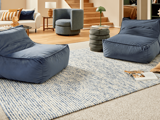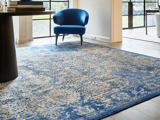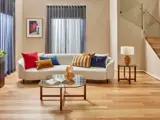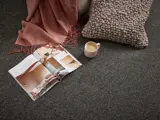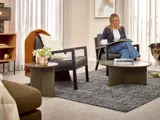Rugs are a powerful element in interior design. The right rug can tie your décor together, add warmth, and make a style statement in any room. Here we share Choices Flooring’s expertise on rug colours and styles to help you match your home’s aesthetic with confidence. From choosing complementary colours to understanding mood effects and trends, this guide covers everything you need to know – all in a professional yet accessible way. We’ll even show you how to use our RoomView tool to visualise rugs in your space before you buy.
Choosing a Rug Colour to Complement Your Décor
Start with your existing palette. Look at the dominant colours in your room – walls, furniture, and accents – and decide whether you want your rug to blend in or stand out. A rug that complements your décor usually either matches one of your room’s accent colours or stays in a harmonious neutral tone. For example, if you have a navy sofa or bold artwork, a rug containing that navy hue (or a shade in that family) can pull the room together. On the other hand, if your furnishings are very vibrant or patterned, a neutral rug in grey, beige or cream can balance the room’s palette without overwhelming it. The goal is to create cohesion – your rug colour should feel like it belongs in the same colour story as the rest of the space.
Decide on subtle vs. statement. If your style is subtle and you prefer a coordinated look, choose a rug colour that echoes other décor elements. You might pick a rug in a slightly lighter or darker shade of your wall or curtain colour, or one that matches scatter cushions and throws. This approach ties the room together seamlessly. For instance, a soft green rug could complement leaf-green indoor plants or artwork in your living room. By contrast, if you want your rug to be a statement piece, you could opt for a bold or contrasting colour that draws the eye. Bright or heavily patterned rugs become a “canvas on your floor”, taking centre stage in the design. In a neutral room, a vibrant rug (deep teal or rich terracotta) can inject personality and be a focal point. Remember that bold rugs work best when they pick up at least one colour from other items in the room, so there’s still a sense of connection.
Use tools to preview colours. Not sure if a particular rug colour will complement your decor? Try uploading a photo of your room to Choices Flooring’s RoomView visualiser to virtually test different rug colours and designs. It’s a great way to see how a rug will look with your wall colour, furniture and flooring, ensuring you make the right choice before committing. Our RoomView tool allows you to “see any of the rugs in [our] catalogue in your own space – before you buy”, taking the guesswork out of colour matching.
Popular Rug Colours and Patterns for Contemporary Homes
Staying on-trend can be fun, and contemporary homes today embrace both timeless neutrals and fresh colour pops. In modern interiors, neutral rugs remain extremely popular – think shades of grey, charcoal, taupe, ivory and beige. Neutral colours are versatile and sophisticated, providing a calm base that lets your furniture and decor shine. It’s no surprise that many homeowners still gravitate toward natural tones; they’re easy to style and unlikely to date quickly. Choices Flooring’s modern rug collection offers a variety of designs in neutral palettes to suit any home.
That said, contemporary style isn’t shy about colour. Earthy hues and rich pigments are trending in 2025’s interiors. Designers are increasingly using rugs in warm, organic colours like terracotta and burnt orange for warmth, as well as deep cobalt blue or emerald green for a dramatic jewel-toned touch. These rich colours add depth and character, especially when paired with neutral walls or flooring for contrast. We’re also seeing soft muted tones like dusty pinks (blush), sage greens, and misty blues in modern boho and Scandi-inspired homes – these bring colour in a subtle, calming way.
When it comes to patterns, geometric and abstract designs continue to dominate contemporary rug trends. Clean-lined patterns such as chevrons, hexagons, and triangles remain popular for their modern appeal. A monochrome black-and-white geometric rug, for example, can make a stylish statement in a minimalist living room. Additionally, many homeowners are drawn to organic patterns and transitional designs – rugs that feature botanical motifs, subtle tribal prints or watercolour-like abstracts. These patterns add interest without feeling old-fashioned. The key is moderation: contemporary style favours either one statement pattern or a cohesive design theme. If your rug is richly patterned, keep other patterns in the room minimal so the look isn’t too busy.
Texture is also big in today’s rug style. High-pile plush rugs, chunky knitted textures, and natural fiber weaves (jute, sisal blends) are being layered into modern spaces to add depth. Textured rugs in neutral colours can create visual interest even without bold patterns or colours. In fact, 2025 is seeing a surge in textural rugs that use varied pile heights and carved effects to make a statement through feel and form rather than bright colour. For a contemporary home, a hand-tufted wool rug in a solid colour (say, an oatmeal or charcoal) but with a sculpted pattern can strike the perfect balance of subtle and stylish.
Remember that rug trends do evolve – each year or season might bring a new colour craze (like Pantone’s Colour of the Year) or pattern revival. But the beautiful thing about rugs is that many styles are timeless. A classic Persian-style patterned rug or a quality neutral wool rug will never truly go out of fashion. If you love it and it suits your home’s vibe, it’s “in style” for you.
The Mood Effect: How Rug Colour Influences a Room
The colour of your rug doesn’t just contribute to visual style – it also affects the mood and atmosphere of your space. Interior designers often leverage colour psychology when selecting furnishings, and your rug is essentially a large swathe of colour underfoot that can change how a room feels.
-
Calming vs. energising: Cool colours tend to create a calm vibe, whereas warm colours energise a space. For instance, a blue rug (especially in softer shades like sky or teal) can make a room feel tranquil and serene, echoing the calming hues of sea and sky. Blue is commonly associated with relaxation and is even found to promote a sense of peace and loyalty. This makes it a great choice for bedrooms or any space you retreat to for unwinding. Green rugs have a similar effect – green is reminiscent of nature and growth, bringing a fresh, rejuvenating feel indoors. A sage or olive green rug can impart a sense of balance and comfort in living areas, creating an inviting, restful environment. On the other hand, warm colours like reds, oranges and yellows will add energy and cosiness. A red rug (think rich burgundy or earthy red tones) can denote passion and warmth; it livens up a room and can even stimulate conversation in social areas. Yellow or gold rugs infuse cheer and brightness – a mustard yellow rug in a foyer, for example, brings an instant feeling of sunshine and optimism (just use yellow thoughtfully, as very bright yellows can be overwhelming in large doses).
-
Bright vs. muted: The intensity of the rug’s colour also matters. Bold, pure colours (bright red, royal blue, emerald) will create a dramatic, high-energy mood and become a focal point. In contrast, muted or pastel versions of those colours (like a dusty rose instead of red, or a powder blue instead of cobalt) evoke a more relaxed, soothing mood while still adding personality. If you want a peaceful vibe, choose rug colours with softer, greyed-out tones; if you want vibrancy, go for the clear, saturated tones.
-
Dark vs. light: Generally, darker coloured rugs make a space feel cosy, intimate or grounded. A charcoal grey or deep navy rug can add a sense of sophistication and warmth, especially in a larger room that you want to make feel more snug. Be mindful that very dark rugs might visually “shrink” a space a little (more on that below), but they often create a dramatic, elegant mood. Conversely, light-coloured rugs (such as ivory, soft beige, pale grey) tend to make a room feel more open, airy, and expansive. Light colours reflect more light, lifting the room’s mood and making it feel spacious and clean. That’s why a cream or light grey rug is popular in smaller rooms or those lacking natural light – it can brighten the overall feel. Just balance light rugs with some darker elements elsewhere (flooring border, furniture legs, etc.) so the space still feels grounded.
In short, think about the emotional ambience you want: invigorating and cosy (warm colours), or serene and airy (cool or light colours). There’s no strict rule – a mix can work well (e.g. a neutral rug with hints of a warm accent colour in its pattern). The right rug colour will support the room’s purpose: soothing in a bedroom, energising in a playroom, elegant in a formal lounge, etc. And if in doubt, neutral tones are a safe bet for a balanced mood.
Matching vs. Contrasting: Rugs and Carpet
A common question is whether your rug should match your carpet (or other flooring) or provide contrast. The answer depends on the look you’re after, but as a rule of thumb, aim for complementary contrast rather than an exact match. You want the rug to feel integrated with the floor and room, but still stand out as its design element.
If you’re layering a rug on carpet (yes, you can put rugs on carpet!), be mindful of texture and pattern. When placing a rug over wall-to-wall carpet, it’s usually best to contrast the textures or patterns so they don’t clash. For example, if you have a plush or patterned carpet, a simpler rug works perfectly – think a solid-colour or subtle-texture rug that won’t fight with the carpet’s design. A natural fibre rug or a thick loop-pile rug in a single colour can look great on a cut-pile patterned carpet. Conversely, if your carpet is plain and neutral, that’s a wonderful opportunity to introduce a bold patterned rug on top. A textured or patterned rug (such as a Persian-inspired print or a modern abstract design) can add interest and definition to a plain carpeted room.
Colour-wise, the safest approach is to coordinate the rug colour with the carpet rather than try to match it exactly. You don’t want the rug to be an exact twin of your carpet colour (which could be futile anyway, as dye lots will differ); instead, choose a rug colour that complements the carpet tone. This could mean staying in the same colour family but a different shade (e.g. a light grey rug on a dark grey carpet, or a navy rug on a light blue carpet), or picking up an accent colour that appears in the room’s scheme. Ensure that the rug colour also ties in with your wall colour or major furniture, so the whole scheme feels intentional. As our experts advise: “Be sure to choose a rug colour that complements the carpet and wall colour to tie the entire colour scheme together.” This creates a harmonious flow from the floor to the walls.
Another tip for rug-on-carpet: pay attention to pattern scale. If the carpet has any pattern or texture, go for a rug with a different scale or no pattern. For instance, a small-scale patterned carpet (like a tiny dot or fleck) can handle a rug with a large-scale pattern, but two bold patterns of similar size will compete. And if both carpet and rug are patterned, make sure the colour palettes are complementary and one pattern is more subtle.
Finally, for a polished look, ensure the rug touches at least one piece of furniture (like a sofa or bed) when on carpet. This anchors the rug so it doesn’t look like it’s just floating on the carpet randomly. When you follow these guidelines, a rug on carpet can look layered and luxurious, adding depth to your design scheme rather than looking out of place.
(If you have hard flooring instead of carpet, similar principles apply: contrast a rug against the floor colour and texture. For example, a light-coloured rug pops beautifully on dark timber floors, whereas a dark rug adds richness on light oak or tiles. Either match undertones for a cohesive look or go for contrast to let the rug “zone” an area – there’s no one right answer, but the rug should neither disappear into the floor nor clash harshly. And don’t forget a rug underlay to keep it safely in place on smooth floors!)
Rug Colours that Hide Dirt and Wear Best
Life happens, especially in high-traffic areas or homes with kids and pets. If you’re concerned about stains or wear, choosing the right rug colour (and pattern) can make maintenance easier by camouflaging the evidence of daily life. Here are some practical tips on dirt-hiding rug colours:
-
Mid-tone colours and multi-colour patterns are your friends. Extremely light rugs (white, cream, pastels) will show every speck of dirt or drop of coffee. On the other hand, very dark rugs (like solid black) hide some stains but will show lint, dust, and pet hair. The sweet spot is often in the middle of the spectrum. Medium-dark shades like charcoal grey, chocolate brown, navy blue, or olive green tend to mask dirt and stains well. These colours are deep enough that a little mark won’t be obvious, but not so dark that every bit of fluff stands out. Even better are heathered or flecked colours (for example, a tweed-like mix of tan and brown, or a subtle mottled grey). A rug that isn’t a flat single colour will naturally conceal dirt.
-
Patterns = camouflage. A rug with an intricate pattern or multi-coloured design is ideal for hiding stains and wear. Our eyes will notice the rug’s pattern and colours before any single stain, so imperfections become far less visible. For high-traffic family rooms or dining areas, consider Persian or oriental-style rugs, Moroccan trellis designs, abstract splatter patterns or any design with variation. These “busy” patterns do an excellent job of disguising spills and foot traffic. Even a simple two-tone geometric or a floral motif can act as a distraction from spots. If you prefer solids, try a textured shag or a berber-style loop rug with flecks of color – the texture and mix of yarn shades will hide dirt better than a smooth, solid cut-pile.
-
Neutral earth tones. Rugs in earthy colours (think medium browns, taupes, greys, and greens) are often chosen for their dirt-hiding ability. These mimic natural dirt tones, so things like dried mud or dust blend in. For example, a speckled grey-beige rug will hide a lot more than a plain white or plain black rug. Likewise, a rug with a mix of beige, charcoal and brown (commonly found in many modern abstract rugs) is excellent for concealing everyday crumbs and wear.
-
Keep context in mind. If you expect heavy wear, also consider material and pile (not just colour). A low-pile, easy-clean rug in a forgiving colour will perform better. For instance, a polypropylene rug in a multicoloured pattern will hide stains and is easy to clean, perfect for a playroom or dining space. Choices Flooring offers many rug options in durable fibres and stain-resistant materials, so you don’t have to sacrifice style for practicality. In entryways, darker mats or rugs with mottled designs will show fewer footprints. And if a section does become worn or faded over time, it will be less obvious if the rug’s colours are variegated rather than a uniform hue.
In summary, go for mid-to-dark tones, multi-tone patterns, and forgiving neutrals when you want a rug that looks good longer. Pair that with regular vacuuming and prompt spot cleaning, and your rug will maintain its beauty for years. (Remember, we also recommend rotating your rug periodically to even out wear, and using a rug pad – good practices for longevity regardless of colour.)
Trends Over Time: How Often Do Rug Styles Change?
Home décor trends, including rug colours and patterns, do evolve – but not at a breakneck pace. Unlike fast fashion in clothing, interior trends tend to shift in annual or multi-year cycles. Typically, you’ll see noticeable changes in colour popularity every few years, influenced by broader design movements and even things like Pantone’s annual Colour of the Year. For example, a few years back, cool greys were the reigning neutral; now we’re seeing a swing toward warmer neutrals and earthy tones. Pattern preferences also shift: one year Moroccan trellis rugs are everywhere, another year it’s all about abstract painterly rugs.
In general, rug colour and pattern trends update gradually. You might find that about every 5–7 years, the mainstream style for rugs looks quite different (just as sofa styles or paint colours change). However, small trend updates happen annually. Designers introduce new collections each season with fresh palettes or motifs to keep things interesting. Right now, we know that maximalism (layering colours, patterns, textures) is having a moment, which means bolder rug choices are in vogue. But a decade ago, minimalism was key, and rugs were more understated. These things are cyclic.
The good news is that quality rugs are an investment, and classic designs remain stylish even as trends come and go. A well-made Persian rug, a solid natural wool rug, or a timeless geometric rug will always have a place. Our advice is to be aware of trends but ultimately choose a rug you love. If you enjoy updating your look often, you can play with on-trend rug colours (since rugs are easier to swap out than an entire floor). Many people have a couple of rugs they alternate seasonally – for instance, a richer coloured rug in winter and a lighter jute rug in summer.
That said, the industry does respond to trend demand fairly quickly. Thanks to versatile manufacturing (like the rise of fast-turnaround hand-tufted rugs), it’s simple to refresh interiors each season or year with new rug styles. Retailers (including Choices Flooring) update their ranges regularly, so you’ll find new patterns and colours in-store every year. If you’re curious about what’s hot right now, keep an eye on our blog and social media for updates on trending designs.
In summary, rug trends change subtly each year and more noticeably every few years, but you don’t need to chase every fad. Balance trend colours with timeless elements. Perhaps incorporate a current colour you love (say, a deep green) in a rug that also has classic neutral tones – that way it will age gracefully even after that particular green might not be “the colour of the year” anymore.
Using Rug Colours to Visually Expand Small Spaces
Did you know the right rug can make a room feel larger? Both the size and colour of your rug play a role in how spacious your room appears. Here are some tips for using rug colour to expand a small space:
-
Go light and bright. In a small or confined room, lighter-coloured rugs tend to open up the space. Just as light wall colours can make a room feel bigger, a rug in a pale neutral or soft pastel can create an airy impression. Ivory, light grey, sandy beige, or even a powder blue or mint green rug will reflect more light and feel less visually heavy on the floor, which gives the sense of a larger room. If you have dark flooring that makes the room feel closed in, placing a light-coloured rug on top can break up that expanse and lift the interior brightness.
-
Use one large rug to unify the space. Visually, a larger rug that almost fills the room will make the room seem bigger, whereas several small rugs or a too-small rug can chop it up. “When choosing a rug for your living room, less is NOT more. Smaller rugs can make a space look smaller or cluttered… in comparison to larger rugs, which give the illusion of a more spacious room.” This advice from our team holds especially true for tight spaces: opt for the biggest rug that fits comfortably (with some floor border visible). The continuous colour/pattern across a large area tricks the eye into seeing a larger expanse. From a colour perspective, a rug that is similar in tone to your flooring (or furniture) can also make the boundaries between surfaces blur, again enlarging the perceived space.
-
Choose calming, uniform patterns or no pattern. In small rooms, avoid very busy, high-contrast rug patterns, which can overwhelm the space. If you want a pattern, go for something with a subtle, tone-on-tone pattern or a simple stripe. A light rug with thin stripes can elongate the room if the stripes run the length of the space. Similarly, a rug with a border can draw the eye outward to the edges, making it seem the floor area extends further. The main idea is to keep the rug design from feeling too visually cluttered. Often, a solid light colour rug (or a natural woven texture in a light tone) is best for a small room – it creates an unbroken, expansive feel.
-
Match the rug to the room’s shape. This is more about size/shape than colour, but worth noting: using a rug shape that fits the room (e.g., a long runner in a narrow hallway, or a round rug in a small entry nook) will utilise the space more effectively and thus look larger. A well-fitted rug in an appropriate colour will always do more for expanding a space than an ill-proportioned one in a great colour.
In summary, light, large, and simple is the formula to make a space feel bigger with a rug. A bright rug that nearly covers the floor, in a cohesive colour, will visually push the walls apart. And remember, you can use our RoomView tool to test how different rug sizes and colours influence your room’s look, helping you choose the perfect option for your cosy space.
Integrating Bold-Patterned Rugs with Your Decor
Bold-patterned rugs – think vibrant geometrics, colourful florals, or striking abstract prints – can completely transform a room. They’re high-impact pieces that showcase your personality. The key to making them work is intentional integration: let the rug be the star while ensuring the rest of the décor supports it.
Make the rug a focal point. If you’ve fallen in love with a rug that has a strong pattern and multiple colours, plan for it to be the primary visual focus in the room. Bold, bright or heavily patterned designs make perfect statement pieces and will leave a lasting impression. Embrace that! Center the seating arrangement around the rug, and don’t hide it – allow as much of it to be visible as possible (e.g., use glass-top coffee tables or float furniture off the rug slightly, if practical). In spaces like bedrooms, dining or lounge areas, a statement rug can set the whole tone of the room.
Pull colours from the rug into the room. A professional decorator trick for a cohesive look is to repeat one or two of the rug’s feature colours elsewhere. For example, if your bold rug has touches of cobalt blue and golden yellow in an abstract pattern, add a few accessories in those hues – a throw pillow, a piece of art, or vases in similar shades. By echoing the rug’s colours in smaller doses, you tie the room together. You can also choose décor items in shades one or two steps away from the rug’s main colour on the colour wheel. This means if your rug is a deep emerald green, accents in lighter sage or a blue-green can complement it nicely without being an exact match. Our mantra: “tie your room together by complementing your rug with décor items that match your rug’s feature colour, or are one to two shades on either side of it.” This approach creates harmony amidst the drama of a bold rug.
Keep other patterns minimal. When you have a rug with a big personality, let it have the spotlight. Avoid upholstering your furniture in equally loud patterns – solid colours or subtle textures for sofas and chairs work best alongside a bold rug. You can mix patterns, but do so carefully: ensure any secondary pattern (perhaps on curtains or cushions) is much smaller in scale or more tone-on-tone so it doesn’t compete. For instance, a large-scale floral rug could be paired with a thin pinstripe pillow or a small herringbone throw – the contrast in scale prevents a clash.
Consider the rug’s style with your theme. A bold rug should still complement the overall style of your home. A modern abstract rug goes well in a contemporary or mid-century styled room with clean-lined furniture. A richly patterned Persian or Moroccan rug can be the star of an eclectic or bohemian room, surrounded by curated finds. Even in a mostly minimalist space, a bold rug can work if it’s the one burst of pattern/colour – just ensure the rug’s style (geometric, traditional, etc.) aligns in spirit with some other element (for instance, a contemporary art piece echoing the rug’s colours, or cushions that hint at the rug’s motif).
Balance boldness with breathing room. Visually, give the eye some rest areas. If the floor is making a statement, maybe keep the walls a solid neutral or vice versa. You can have pops of the rug’s colours around, but also include plenty of neutral or white space so the room doesn’t feel chaotic.
Finally, confidence is key: a bold-patterned rug, when chosen with love, can truly make your space feel unique and styled. Don’t be afraid to let your rug reflect your personality. If you’ve integrated its colours and respected its prominence, your room will look intentionally designed. And remember, if you ever want to experiment, you can preview how a bold rug will look in your room with RoomView – that way, you can be sure the scale of pattern and colours fit your vision before you commit.
Bringing It All Together: Find Your Perfect Rug
A well-chosen rug is like the finishing touch that pulls your whole interior together. By considering colour relationships, pattern balance, and the mood you want to create, you can select a rug that truly matches your home’s aesthetic. Whether you opt for a quiet neutral or a show-stopping design, the rug should feel right at home in your space.
Choices Flooring is here to help at every step. We offer an extensive range of rug styles – from modern and contemporary designs to natural fibre textures and timeless traditional patterns – so you’re sure to find one that speaks to your taste. Once you have a few favourites, take advantage of our RoomView online visualiser to “see any rug in [your] own space – before you buy”. Simply upload a photo of your room and try out different rug colours and styles with a click. It’s a fun, easy way to preview how a rug complements your décor (and it takes the guesswork out of matching colours!).
Ready to transform your room with the perfect rug? Explore our Rugs collection to browse by style, colour and size, and give our RoomView tool a go for that extra peace of mind in your decision. With the right rug in place, you’ll enjoy a home that feels stylish, cohesive, and truly yours. Here’s to finding the rug you’ve been searching for – and elevating your home’s aesthetic from the ground up.



